When you were a kid, being the disruptive one in the class was a bad thing. Who knew that we’d all be clamoring to be the most disruptive kid on the block some years later?
When it comes to business, digitally native vertical brands (DNVBs) are some of the most disruptive, innovative, and fast-scaling businesses on the market. On average, they grow at triple the rate of other e-commerce businesses.
They also pique the interests of investors. In 2020, DNVBs comprised 15 percent of new unicorns, up 5 percent from the previous year.
In other words, DNVBs are on the rise and they’re doing extremely well.
So if you’re astute and considering starting a business using this model, here you’ll find some of the best digitally native vertical brand examples you can learn from.

What Is a Digitally Native Vertical Brand?
There are two main elements that make a company a digitally native vertical brand.
First, being digitally native means that the brand is founded on the web and conducts its business online. That’s not to say it won’t expand to brick and mortar at a later date, however.
The vertical part of the title refers to the fact that the brand is vertically integrated. Meaning, the brand is in charge of every aspect of the product and customer journey from design and production all the way through to sales and distribution.
So, a digitally native vertical brand is a company that designs and creates its own products and starts out by selling them to customers from its own website.
7 Killer Digitally Native Vertical Brand Examples
1. Warby Parker
One of the reasons DNVBs can do so well is an efficient supply chain. They cut costs by cutting out the middleman.
They’re in charge of the entire journey from when a product is manufactured in a factory to when it reaches the customer’s doorstep. This means that DNVBs can bring products to market at a lower price point than competitors.
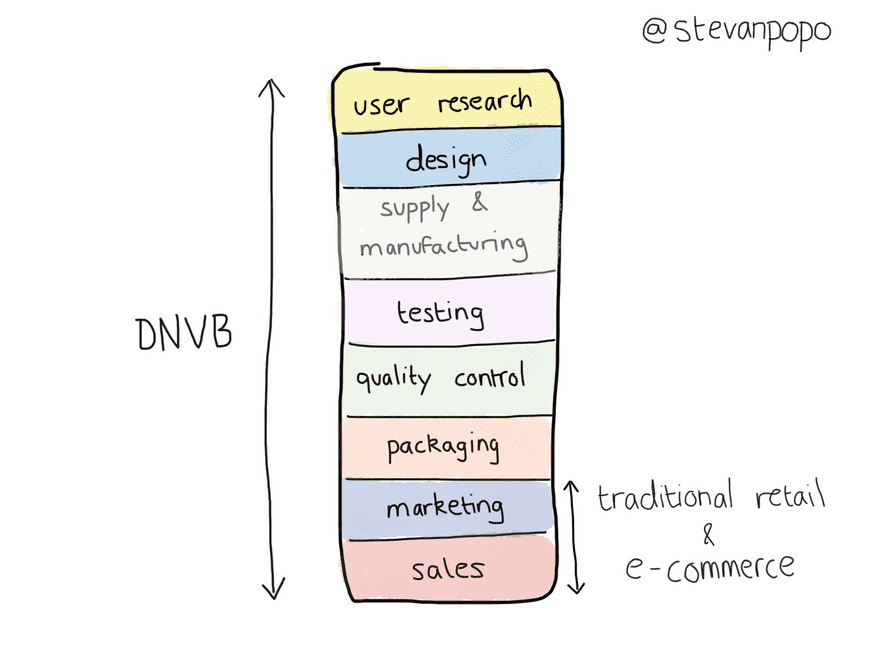
This brings us to the founding of Warby Parker. The company’s founders realized that one company had a monopoly over the eyewear market. It was keeping prices high and laughing all the way to the bank.
Hence, Warby Parker decided to do something different: “By circumventing traditional channels, designing glasses in-house, and engaging with customers directly, we’re able to provide higher-quality, better-looking prescription eyewear at a fraction of the going price.”
For this reason, it’s possible for Warby Parker to be transparent with its customers about the design and creation of its eyewear.
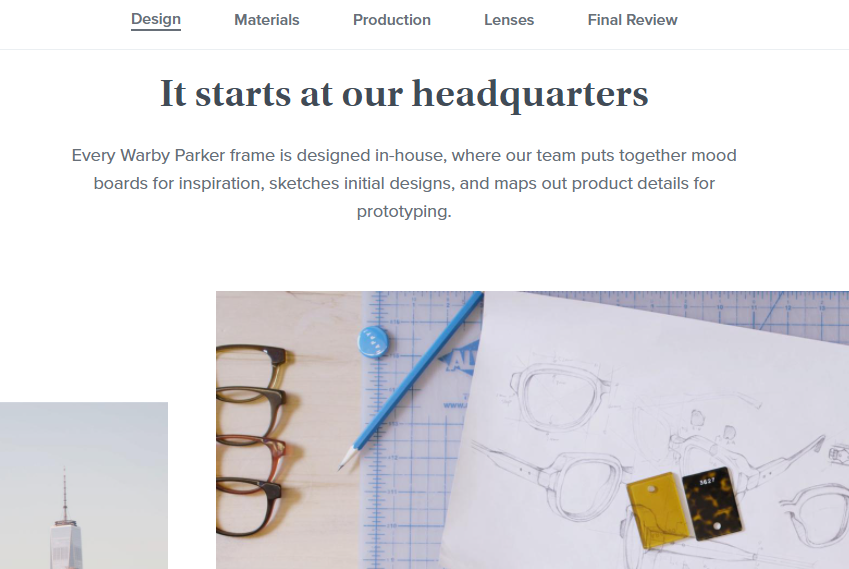
This level of care and transparency is what makes the brand so appealing to customers. And it’s only achievable with this type of business model.
To emulate the success of Warby Parker and other DNVBs you’ll need to take over production early on. It might mean setting up a factory from scratch or buying out existing factories in the industry you wish to operate in. Then you can take charge, create a quality product and enjoy the higher margins.
2. Casper
DNVBs rely on simplicity. They start by obsessively focusing on a single product in an industry that they believe needs an overhaul. The goal is to do that product better than anybody else and to offer unique selling points (USPs) that others haven’t thought of.
This is true of Casper. It started with one mattress that it designed and sold online in six different sizes.
Casper’s USP, which they became extremely well-known for, was the 100-day money-back guarantee. They created this offer to contrast a tired industry’s norm which at the time was “if you try a bed for two minutes while you’re awake, you’ll find the best long-term mattress for you.”
To start a successful DNVB, you must, like Casper, begin with the customer in mind and solve their pain points with a superior experience. Casper made $1 million in its first 28 days based on this principle.
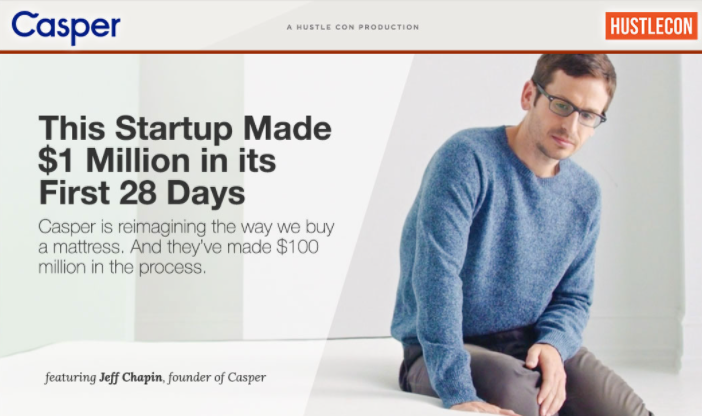
Starting small also eliminates the paradox of choice. This is the idea that faced with too many choices a customer is more likely to just give up and not make a choice.
So start with one product or one line of products. You can expand into more products later or upsell and cross-sell related products as Casper now does.
These days the mattress company has a range of bed frames, bedding, and further related items.
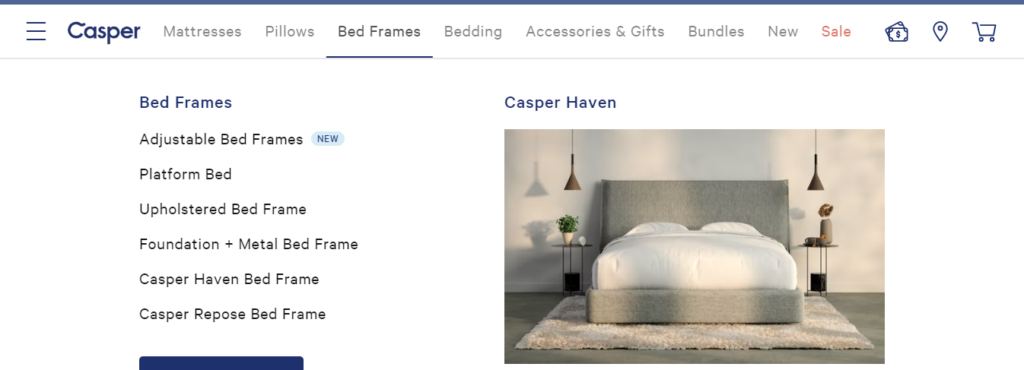
3. Harry’s
New DNVBs tend to use “growth hacking” to gain early momentum. Simply put, it’s when startups attempt to achieve large growth quickly and on a small budget.
Shaving company Harry’s had great success with growth hacking in the early stages. Prior to launching, it created a social media campaign that used alluring teasers to drive traffic to a landing page.
People then signed up with their email addresses and were encouraged to make referrals through a tiered rewards system.
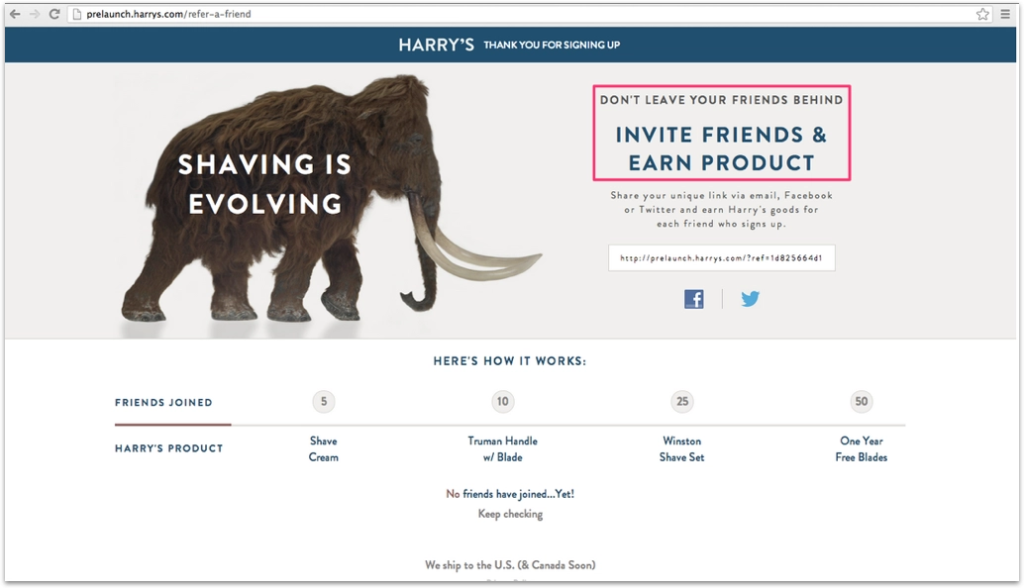
If somebody made five referrals they received a free shave cream. And if they made fifty referrals they received one year of free razor blades. So the rewards get increasingly better.
This is a clever way to generate buzz and build an email list that you can later utilize to build customer loyalty and sell more. This tactic worked so well for Harry’s that 77 percent of email subscribers from the initial campaign came via referral.
If you want to try your hand at growth hacking, incentivized referrals could work well. You could also aim for viral content and try partnering with influencers or online publications that are popular with your demographic.
4. Bonobos
A superior customer experience sets DNVBs apart from the old fuddy-duddy e-commerce stores.
Since DNVBs can monitor and control every single customer touchpoint, it’s easy to make the experience consistent and simple. And experience-driven brands report 1.6x to 1.9x higher year-on-year growth in repeat purchase rate, customer retention, average order value, and customer lifetime value.
Bonobos is one of the most popular DNVBs. In 2016, its founder, Andy Dunn, wrote about being “maniacally focused on the customer experience” and how it drives closer connections with customers than the competition could ever achieve.
Since Bonobos is able to capture so much data throughout the entire customer journey, they’re able to offer both a better product and better service than other clothing companies, such as an extensive range of fits and sizes.
They even have so-called Guideshops now that customers can visit in person for a one-on-one shopping experience.
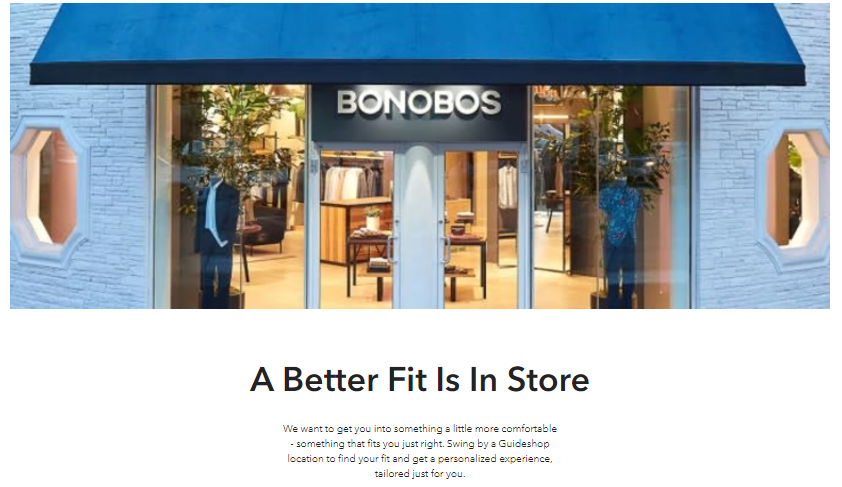
DNVBs can and do successfully expand into brick and mortar stores later in life. In the case of Bonobos, Guides collect all of the customer’s style and fit information. The products they purchase are delivered to the customer’s home. It’s a nice complement to the e-commerce store and a unique way of putting the customer first.
5. Away
The DNVB model allows you to improve the user experience right down to the product design level. It’s about making a product better, not just marketing it better.
Luggage company Away does this by having a complete understanding of its customers’ needs. After developing a prototype of their first piece of luggage, the brand carried out user testing, focus groups, and surveys to perfect it.
This helped them add and remove features based on user requirements. And there are indeed many innovative, helpful features within the products aimed at making customers’ lives easier, such as a laundry bag that you can compress into the suitcase.
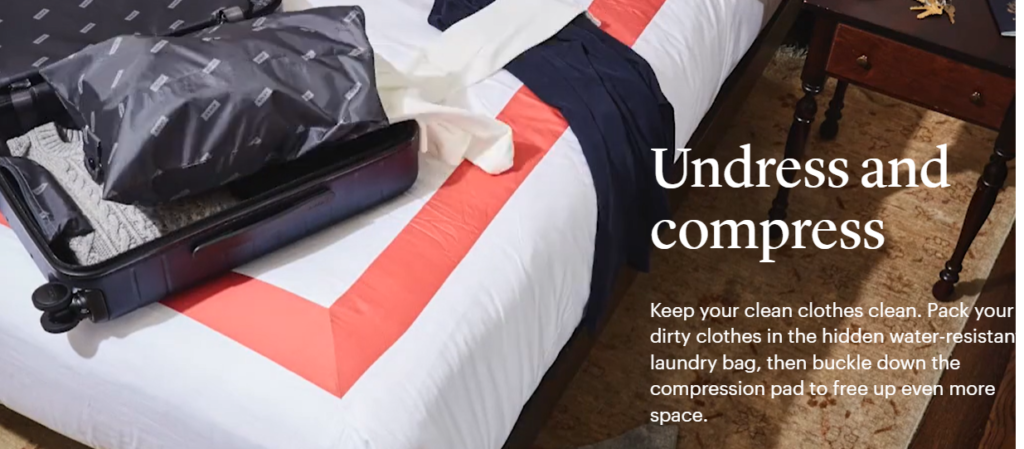
The moral of the story here is to hone in on your target audience and what they need from a product in your chosen vertical.
By doing careful customer research, you can differentiate your product from the existing market. And in the case of Away, it really shows in customer responses like this one from their homepage, “I love Away! From the thoughtfully created products to the customer service team that seems to go above and beyond, everything is exactly how I’d want it to be.”
Even though the customer doesn’t realize it, we know there are no coincidences here. Everything is exactly how the customer wants it to be because it was designed in that way.
6. Glossier
Most DNVBs have a carefully thought out set of brand values that they take seriously. This helps to form connections with customers and build loyalty around a joint mission.
Cosmetics company Glossier has always done an excellent job in this respect. The company sought to overhaul what has been traditionally done in the beauty industry in line with emerging trends and perspectives.
People were becoming sick of being told how to look or urged to cover up imperfections. They also started seeing makeup as more of a creative outlet. Glossier ran with these ideas and decided to create new beauty products from scratch that have since become cult favorites. They have a small range, specializing in a few key items.
This minimalism is reflected in the aesthetic of natural beauty that the company tries to promote through products that enhance rather than cover-up. These are the brand values you can see sprinkled through their content.
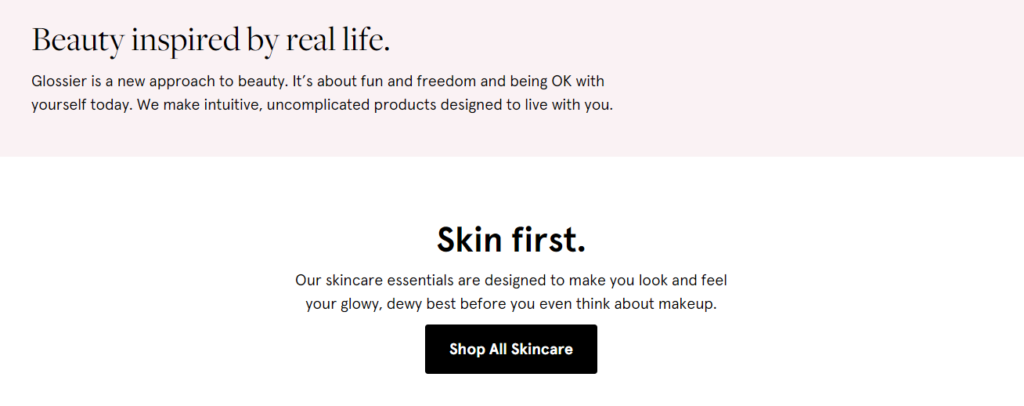
Their mission and motto became “Skin first, makeup second”. You can emulate this by having a clear idea about what your brand stands for and what your customers care about.
Don’t forget that you have to put your money where your mouth is, however. If you talk about your brand’s values, you must also adhere to them if you want to create genuine relationships with customers.
7. Burrow
Competition among e-commerce stores is on the up, and so are customer expectations.
In fact, 73 percent of customer support professionals say customer expectations are increasing, while only 42 percent believe they’re meeting those expectations.
The good news is, DNVBs might have an edge here too.
As you’ve seen, the nature of the business model helps them get one over on competitors while exceeding customer expectations. The ability to personalize offerings to customers contributes significantly to the success of DNVBs. Through customization options, they stand out and help customers get precisely what they need.
This is the case for online furniture company Burrow, which sells modular pieces that can make up “countless possible configurations”.
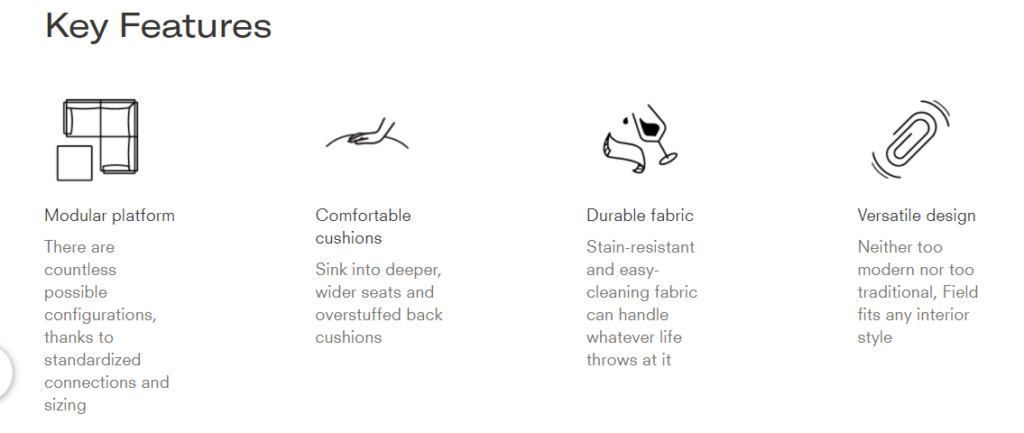
Customers are able to design and order furniture online and have it delivered for free. It’s a unique, fun, and seamless customer experience.
Remember that if you operate a DNVB, it’s possible to make, sell and distribute products exactly as the customers want them because you’re running the show.
But you must proceed with caution. You don’t want to overcomplicate things for the customer. Start small when it comes to customization.

Conclusion
Digitally native vertical brands have a similar core business model and follow similar strategies to success, even if their products and principles are unique.
Here are the main threads running through all of these fantastic digitally native vertical brand examples:
- Take an outdated product or industry and refresh it with customer needs in mind;
- Create a 10x better product and provide a 10x better customer experience than everybody else;
- Keep it simple, start with a singular focus and expand later; and
- Understand your customers to the very depths of their souls.
Wondering where to start? Begin by conducting customer research that’ll help you figure out how you can better serve your target audience with a DNVB.



